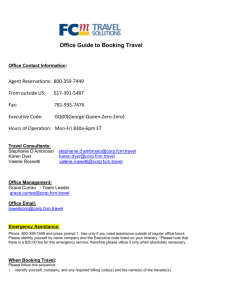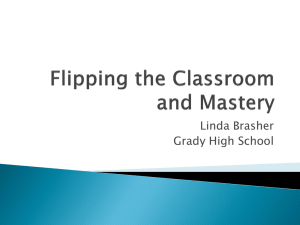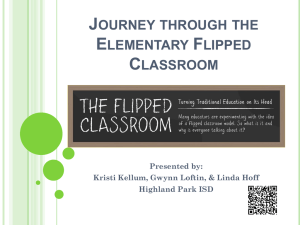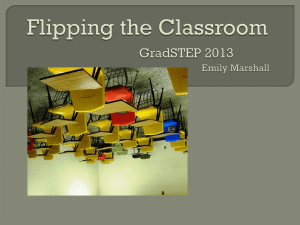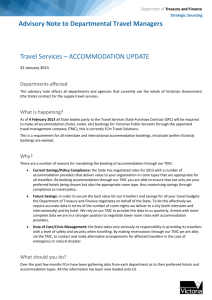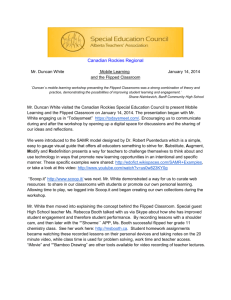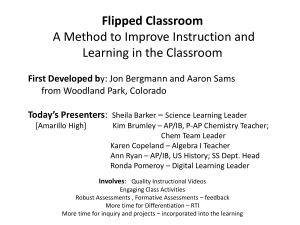Laura Sullivan-Green, Student Satisfaction in a Flipped Classroom
advertisement
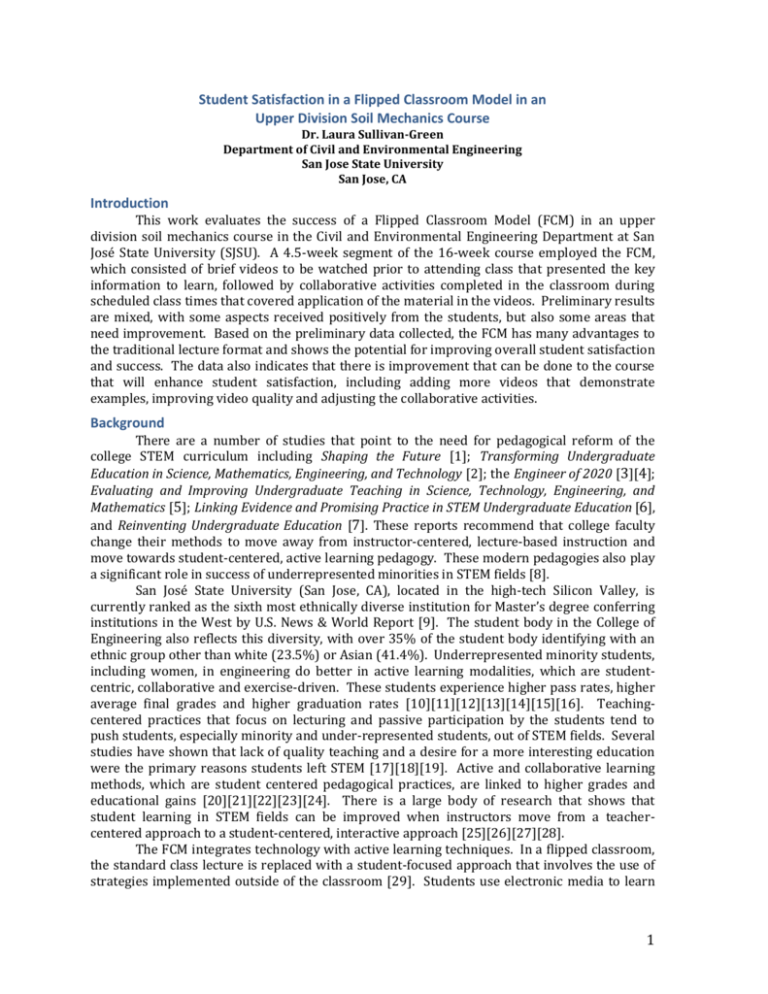
Student Satisfaction in a Flipped Classroom Model in an Upper Division Soil Mechanics Course Dr. Laura Sullivan-Green Department of Civil and Environmental Engineering San Jose State University San Jose, CA Introduction This work evaluates the success of a Flipped Classroom Model (FCM) in an upper division soil mechanics course in the Civil and Environmental Engineering Department at San José State University (SJSU). A 4.5-week segment of the 16-week course employed the FCM, which consisted of brief videos to be watched prior to attending class that presented the key information to learn, followed by collaborative activities completed in the classroom during scheduled class times that covered application of the material in the videos. Preliminary results are mixed, with some aspects received positively from the students, but also some areas that need improvement. Based on the preliminary data collected, the FCM has many advantages to the traditional lecture format and shows the potential for improving overall student satisfaction and success. The data also indicates that there is improvement that can be done to the course that will enhance student satisfaction, including adding more videos that demonstrate examples, improving video quality and adjusting the collaborative activities. Background There are a number of studies that point to the need for pedagogical reform of the college STEM curriculum including Shaping the Future [1]; Transforming Undergraduate Education in Science, Mathematics, Engineering, and Technology [2]; the Engineer of 2020 [3][4]; Evaluating and Improving Undergraduate Teaching in Science, Technology, Engineering, and Mathematics [5]; Linking Evidence and Promising Practice in STEM Undergraduate Education [6], and Reinventing Undergraduate Education [7]. These reports recommend that college faculty change their methods to move away from instructor-centered, lecture-based instruction and move towards student-centered, active learning pedagogy. These modern pedagogies also play a significant role in success of underrepresented minorities in STEM fields [8]. San José State University (San Jose, CA), located in the high-tech Silicon Valley, is currently ranked as the sixth most ethnically diverse institution for Master’s degree conferring institutions in the West by U.S. News & World Report [9]. The student body in the College of Engineering also reflects this diversity, with over 35% of the student body identifying with an ethnic group other than white (23.5%) or Asian (41.4%). Underrepresented minority students, including women, in engineering do better in active learning modalities, which are studentcentric, collaborative and exercise-driven. These students experience higher pass rates, higher average final grades and higher graduation rates [10][11][12][13][14][15][16]. Teachingcentered practices that focus on lecturing and passive participation by the students tend to push students, especially minority and under-represented students, out of STEM fields. Several studies have shown that lack of quality teaching and a desire for a more interesting education were the primary reasons students left STEM [17][18][19]. Active and collaborative learning methods, which are student centered pedagogical practices, are linked to higher grades and educational gains [20][21][22][23][24]. There is a large body of research that shows that student learning in STEM fields can be improved when instructors move from a teachercentered approach to a student-centered, interactive approach [25][26][27][28]. The FCM integrates technology with active learning techniques. In a flipped classroom, the standard class lecture is replaced with a student-focused approach that involves the use of strategies implemented outside of the classroom [29]. Students use electronic media to learn 1 about the content before class, allowing them to learn at their own pace and come better prepared for in-class work. This approach is shown to have a positive effect on student learning outcomes, especially in STEM courses [30]. High need students also see improvements with these active learning methods [31]. These improvements increase academic self-confidence, motivate students to persist in difficult academic pathways, motivate students to complete one’s academic study and improve the likelihood of pursuing advanced study [32]. By incorporating these changes into the civil engineering curriculum at SJSU, all students, and especially the large number of underrepresented minority students, will have courses that cater to their unique needs within their curriculum. Course Development The required geotechnical engineering course, CE 140: Introduction to Soil Mechanics is currently testing the FCM. The first unit, a 4.5-week segment, introduces students to the importance of a soil investigation in a civil engineering project, the origin of soils and various methods to define a soil, both by its physical properties and its behaviors. Students have a series of videos, 5-10 minutes in length, that present the content to be covered. Each lesson has 1-3 videos, depending on content and length. The videos are to be watched prior to attending the class for which the work is assigned. Each series of videos is followed by a brief 3-question quiz on Canvas, the course management system. The system is set up so that students are unable to take the quiz without first watching the videos and also from continuing in the module until a satisfactory grade is achieved on the quiz. The quizzes contain information regarding key concepts in the video(s) just seen. The quizzes also provide the instructor with input on the students’ preparation for the class. Once the videos and quizzes are completed, the student will have access to a homework assignment. The homework assignments are short 3-5 question (as opposed to a standard 7-8 question) assignments that compliment the activities carried out during class. During the class sessions students will be given an activity that has 2-3 questions. Students will work collaboratively in groups of 3-5 to find solutions to the activity problems, which enforce and enhance concepts learned in the videos. The combination of the shortened homework and the class activities would be comparable to the work for a typical homework assignment in the traditional class format. Results and Discussion Student satisfaction with the FCM was measured by an online survey that was modeled after the survey by G.B. Johnson in “Student Perceptions of the Flipped Classroom” [33]. Students were asked a series of questions about the FCM and asked to rank their opinion on a scale from 1 (strongly disagree) to 5 (strongly agree). They were then given the opportunity to provide feedback on what they liked and didn’t like about the FCM. Students were collectively more in agreement on their positive feelings about the FCM. Tables 1 and 2 present results of the survey for the Fall 2013 and Spring 2014 cohorts, respectively. Table 3 summarizes comments that students made about what they liked about the FCM. Around half (52.6%, 50%) of the students believed that the flipped classroom model was more engaging than traditional classroom instruction. Their comments were also more consistent, with 31-46% (31.7%, 46.4%) saying they liked that they could rewatch the lecture videos whenever they chose. Another positive aspect of the FCM was that students felt that it allowed them to work at their own pace (29.3%, 32.1%) and enabled them to pace themselves successfully through the course (47.4%, 64.3%). A majority (50%, 57.1%) agreed that the FCM gave them more time to work with fellow classmates and commented that they had more access to the professor and classmates when problem-solving (17.1%, 14.3%). Less than one third of students (31.6%, 25%) stated that they didn’t like the videos, with the remaining percentage either being neutral (26.3%, 17.9%) or positive (42.1%, 57.1%) about them. 2 Table 1. Results from student survey reporting positive support with the FCM in Fall 2013. Disagree/ Agree/ Strongly Strongly Disagree Neutral Agree Mean Responses Statement The Flipped Classroom is more engaging than traditional classroom instruction. No. The Flipped Classroom gives me greater opportunities to communicate with other students. I like watching the lessons on video. I find it easy to pace myself successfully through the course. The Flipped Classroom gives me less class time to practice soil mechanics. % No. % No. % No. 14 36.8 4 10.5 20 52.6 3.21 38 12 31.6 5 13.2 21 55.3 3.37 38 12 31.6 10 26.3 16 42.1 3.16 38 10 26.3 9 23.7 18 47.4 3.34 38 19 50 9 23.7 10 26.3 2.61 38 Table 2. Results from student survey reporting positive support with the FCM in Spring 2014. Statement The Flipped Classroom is more engaging than traditional classroom instruction. Disagree/ Strongly Disagree Neutral No. No. The Flipped Classroom gives me greater opportunities to communicate with other students. I like watching the lessons on video. I find it easy to pace myself successfully through the course. The Flipped Classroom gives me less class time to practice soil mechanics. % Agree/ Strongly Agree % No. Mean % Responses No. 8 28.6 6 21.4 14 50 3.32 28 9 32.1 3 10.7 16 57.1 3.36 28 7 25 5 17.9 16 57.1 3.39 28 4 14.3 6 21.4 18 64.3 3.68 28 14 50 8 28.6 6 21.4 2.61 28 Table 3. Results from student comments reporting what they liked about FCM. Student Likes Ability to rewatch videos Abilty to work at own pace Accessibility of professor/classmates during problem solving Videos (usefulness, duration, access) Fall 2013 13 (31.7%) 12 (29.3%) Spring 2014 13 (46.4%) 9 (32.1%) 7 (17.1%) 4 (14.3%) 3 (7.3%) 2 (7.1%) 3 Negative comments from students tended to be less consistent among the students. Fewer students were in agreement about what they didn’t like about the FCM. Tables 4 and 5 present results from the survey for the Fall 2013 and Spring 2014 cohorts, respectively. Table 6 summarizes the most popular comments that students reported when asked what they didn’t like about the FCM. Most students (51.4%, 64.3%) disagreed with the statement that that they were spending less time with the FCM on soil mechanics than they would have with a traditional format. Their comments also supported this assssment with 14.6% and 10.7% commenting that the format felt more time consuming than a traditional class. Despite reporting that they liked the ability to rewatch the videos and pace themselves with the video/quiz/activity/homework sequence, 47.4% and 50% reported that they would still prefer a traditional lecture format in the class. The greatest complaint in the comments was in regards to the activity format (19.5%, 17.9%). Students’ complaints covered numerous aspects of the activities, including the format, length, and grading. The over-arching theme of the details was that the activities were too stressful due to worry about completion during the class time and impact on grades if did not complete to make the collaboration effective. Students were using the divide-and-conquer method for completion, which defeated the purpose of working together and learning from peers. Table 4. Results from student survey reporting negative support for the FCM in Fall 2013. Disagree/ Agree/ Strongly Strongly Disagree Neutral Agree Mean Responses Statement I am spending less time working on traditional Soil Mechanics homework. I would rather watch a traditional teacher lead a lesson than a lesson video. No. % No. % No. % No. 19 51.4 9 24.3 10 27 2.63 37 5 13.2 15 39.5 18 47.4 3.53 38 Table 5. Results from student survey reporting negative support for the FCM in Spring 2014. Disagree/ Agree/ Strongly Strongly Disagree Neutral Agree Mean Responses Statement I am spending less time working on traditional Soil Mechanics homework. I would rather watch a traditional teacher lead a lesson than a lesson video. No. % No. % No. % No. 18 64.3 2 7.1 8 28.6 2.54 28 5 17.9 9 32.1 14 50 3.39 28 Table 6. Results from student comments reporting what they did not like about FCM. Student Dislikes Fall 2013 Spring 2014 Activity format (length, grading, solutions) 8 (19.5%) 5 (17.9%) Time consuming 6 (14.6%) 3 (10.7%) Video quality 1 (2.4%) 3 (10.7%) Videos not engaging/boring 3 (7.3%) 4 Students were inconsistent across the two semesters on two points, their motivation to learn soil mechanics and their level of learning of soil mechanics. In Fall 2013, students were more likely to disagree with these statements (36.8% against motivation and 39.5% against improved learning). In Spring 2014, students were more likely to agree with these statements (40.7% for motivation and 35.7% for improved learning. More students were also in the Neutral category in Spring 2014 than compared to Fall 2013. More data needs to be collected to evaluate these aspects of the FCM. Table 7. Results from student survey with inconclusive results for/against the FCM from Fall 2013. Disagree/ Agree/ Strongly Strongly Disagree Neutral Agree Mean Responses Statement I am more motivated to learn soil mechanics in the Flipped Classroom. The Flipped Classroom has not improved my learning of soil mechanics. No. % No. % No. % No. 14 36.8 13 34.2 11 28.9 2.95 38 15 39.5 10 26.3 12 31.6 2.81 38 Table 8. Results from student survey with inconclusive results for/against the FCM from Spring 2014. Disagree/ Agree/ Strongly Strongly Disagree Neutral Agree Mean Responses Statement I am more motivated to learn soil mechanics in the Flipped Classroom. The Flipped Classroom has not improved my learning of soil mechanics. No. % No. % No. % No. 6 22.2 10 37 11 40.7 3.22 27 9 32.1 9 32.1 10 35.7 3.37 28 Results tend to show that satisfaction with the fundamentals of the FCM outweigh the negative attitudes towards the method. More people are in agreement that the video lecture concept improves their ability to learn course content by review of the videos at the students’ discretion and to pace themselves through the course material. The collaborative working environment is received well by the students, but improvements need to be made to the course format to maximize the benefits of this working in groups. The additional time reported, whether actual or perceived, on working with the course content with FCM is currently perceived as a negative to the method and additional investigation is needed to evaluate if there are any benefits (improved grades and passing rate) that justify the additional expenditures to the student to reduce these negative perceptions. Several comments that were not consensus across the student body, but have potential for further evaluation are worth mentioning here. One student stated that the FCM was beneficial to his/her educational experience because of their diagnosis with Attention Deficit Disorder. The student reported that they were able to watch the videos again if they “spaced out.” This comment supports the literature, mentioned 5 above, that shows that these active teaching methods help high-need, high-risk students the most. Another student commented that they were able to have time to reflect on the material before moving on, a luxury not afforded in a traditional classroom that many students may not even identify as an important component of their education because it is not compatible with a time-limited lecture. One more student stated that they liked having full time access to the lectures, again another luxury not afforded to students, as a professor is not available limitlessly. The survey also highlighted several areas of improvement, namely with the activities. The activity format needs to change to provide students more time to utilize their group members as resources and work together towards a common solution. A better balance needs to be achieved that forces students to stay on task, while simultaneously not causing stress due to a limited time constraint and worry over a grade. Another area that is in need of improvement includes the time commitment perception. This is a two-sided problem. First, the perception that additional time spent on study is negative needs to be adjusted. Second, the combination of the smaller homework and the activities were thought to eliminate half the homework obligation, may not be accurate. The additional time to work a problem collaboratively over that of a standard work-alone method may need to be accounted for and the homework length reduced accordingly. Conclusion The Flipped Classroom Model was tested in a 4.5-week unit of an upper division soil mechanics class at San Jose State University. Videos containing lecture content were posted for students to watch prior to attending class. During class, students worked collaboratively to solve relevant problems based on that content. Smaller homework assignments were then given to reflect the work in the classroom. Results shows students were satisfied with the video concept and enjoyed the ability to watch the videos whenever they wanted and as many times as they wanted. They enjoyed the ability to pace themselves with the coursework over the 4.5 weeks. Students identified several areas that were not satisfactory, including a reported increase in time spent on the course and the format of the in-class activities. Areas that are slated for reevaluation include the format for the activities and correlated homework and evaluation of the expected time required for success in the course. 1 2 3 4 5 National Science Foundation (1996). Shaping the future: New expectations for undergraduate education in science, mathematics, engineering, and technology. Washington, DC: NSF DUE. National Research Council. (1999). Transforming undergraduate education in science, mathematics, engineering, and technology. Washington, DC: National Academy Press. National Academy of Engineering (2004). The engineer of 2020. Washington, DC: National Academies Press. National Academy of Engineering (2005). Educating the engineer of 2020: Adapting engineering education to the next century. Washington, DC: National Academies Press. Fox, M. A., & Hackerman, N. (Eds.). (2003). Evaluating and improving undergraduate teaching in science, technology, engineering, and mathematics. Washington, DC: National Research Council. 6 6 7 8 9 10 11 12 13 14 15 16 17 18 19 20 21 22 23 24 25 Fairweather, J. (2009). Linking Evidence and Promising Practices in Science, Technology, Engineering, and Mathematics (STEM) Undergraduate Education, a Status Report for The National Academies National Research Council Board of Science Education, number 17. The Boyer Commission on Educating Undergraduates in the Research University. (1998). Reinventing undergraduate education: A blueprint for America’s research universities. Available: http://naples.cc.sunysb.edu/Pres/boyer.nsf/ Gaffney, J. D., Richards, E., Kustusch, M. B., Ding, L., & Beicher, R. (2008). Scaling up educational reform. Journal of College Science Teaching, 37(5), 48-53. U.S. News and World Report. (2010). Campus diversity ranking. America's best colleges 2010. Treisman, U. (1992). Studying students studying calculus: A look at the lives of minority mathematics students in college. The College Mathematics Journal, 23(5):362–372. Chinn, D., Martin, K., & Spencer, C. (2007). Treisman workshops and student performance in CS. ACM SIGCSE Bulletin, 39(1): 203–207. Fullilove, K., & Treisman, U. (1986). Mathematics achievement among African-American undergraduates in the University of California, Berkeley: An evaluation of the mathematics workshop program. The Journal of Negro Education, 59(3), 463–478. McFarland, R.D. (2004). Effective design considerations to address Hispanic MIS/CS curriculum. Journal of Computing Sciences in Colleges, 20 (1). Burn, H., & Holloway, J. (2006). Why should I care? Student motivation in an introductory programming course. Proceedings of the 2006 ASEE Annual Conference and Exposition, 18-21 June 2006, Chicago, IL. The University of Colorado-Boulder Multicultural Engineering Program. (2007). Impacting the Achievement of Underrepresented Minorities in Science and Engineering. 2007 Conference on the Preparation of Physics and Physical Science Teachers. Rath, K.A., Peterfreund, A.R., Xenos, S.P., Bayliss, F., & Carnal, N. (2007). Supplemental instruction in Introductory Biology I: Enhancing the performance and retention of underrepresented minority students. CBE-Life Sciences Education, 6, 203-216. Hewitt, N. M. & Seymour, E. (1992). A long discouraging climb, ASEE PRISM, 1(6), 24-28. Astin, A. W. (1993). Engineering outcomes. ASEE Prism, pp. 27-30. Tobias, S. (1990). They’re not dumb, they’re different: Stalking the second tier. Tucson, AZ: Research Corporation. Kuh, G. D. (2007). Risky business: Promises and pitfalls of institutional transparency. Change, 39(5) 30-35. Zhao, C., Carini, R. M., & Kuh, G. D. (2005). Searching for the Peach Blossom Shangri-La: Student Engagement of Men and Women SMET Majors, The Review of Higher Education, 28(4), 503-525. Johnson, D., Johnson, R, & Smith, K. (1998). Active learning: Cooperation in the college classroom (2nd ed.). Edina, MN: Interaction Book Co. De Caprariis, P., Barman, C., & Magee, P. (2001). Monitoring the benefits of active learning exercises in introductory survey courses in science: An attempt to improve the education of prospective public school teachers. The Journal of Scholarship of Teaching and Learning, 1(2), 1-11. Chickering, A. W., & Gamson, Z. F. (Eds.). (1987). Seven principles for good proactive in undergraduate education. AAHE Bulletin, 39, 3-7. Handelsman, J., Ebert-May, D., Beichner, R., Bruns, P., Chang, A., DeHaan, R., Gentile, J., Lauffer, S., Stewart, J., Tilghman, S. M., & Wood, W. B. (2004). Education: Scientific teaching. Science, 304(5670), 521-522. 7 26 27 28 29 30 31 32 33 Peters, A. W. (2005). Teaching biochemistry at a minority-serving institution: An evaluation of the role of collaborative learning as a tool for science mastery. Journal of Chemical Education, 82(4), 571-574. Christensen, T. (2005, November-December). Changing the learning environment in large general education astronomy classes, Journal of College Science Teaching, 35(3), 34-38. Fenci, H., & Scheel, K. (2005). Engaging students. An examination of the effects of teaching strategies on self-efficacy and course climate in a nonmajors Physics course. Journal of Research in Science Teaching, 35(1), 20-24. Hughes, H. (2012). Introduction to flipping the college classroom. In T. Amiel & B. Wilson (Eds.), Proceedings of the World Conference on Educational Multimedia, Hypermedia and Telecommunications 2012 (pp. 2434-2438). Chesapeake, VA: AACE. Christensen, T. (2005, November/December). Changing the learning environment in large general education astronomy classes. Journal of College Science Teaching, 34-38. Milem, J. (2001). Increasing diversity benefits: How campus climate and teaching methods affect student outcomes. In Diversity challenged. Cambridge, MA: Harvard Education Publishing Group Adair, J.K., Reyes, M.A., Anderson-Rowland, M.R., & Kouris, D.A. (2001 Workshops vs. tutoring: How ASU’s minority engineering program is changing the way engineering students learn. In Proceedings of the 31st ASEE/IEEE Frontiers in Education Conference, volume 2, pp. T4G–7–T4G–11, October 2001. Johnson, G.B. (2013). “Student Satisfaction of the Flipped Classroom”. Retrieved from https://circle.ubc.ca/handle/2429/44070. May 22, 2014. 8

